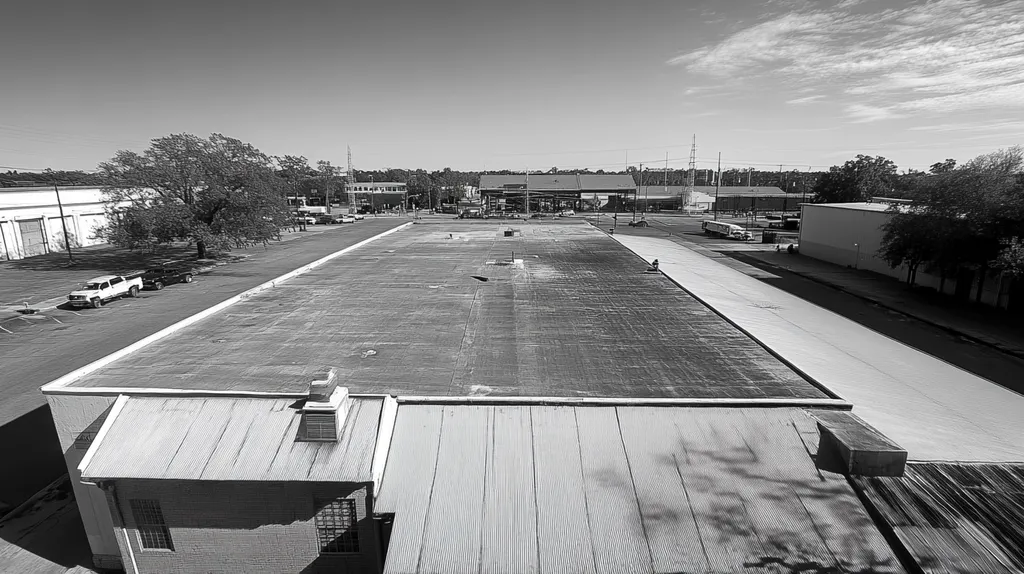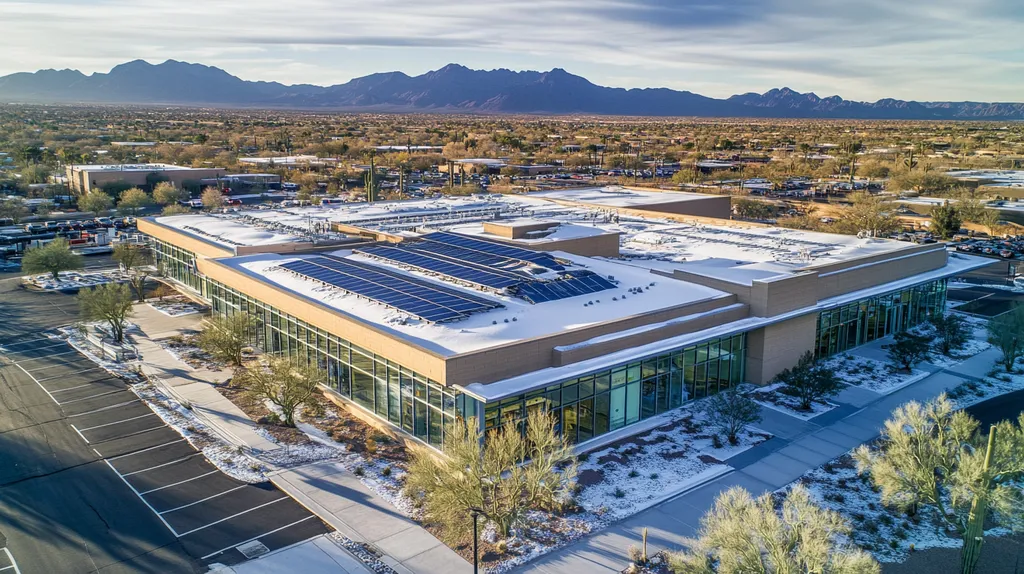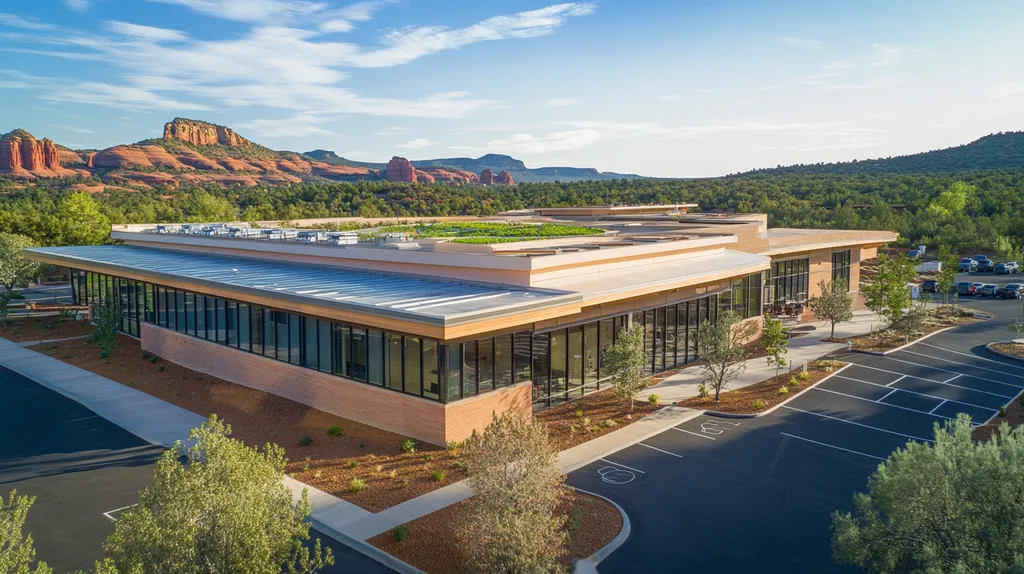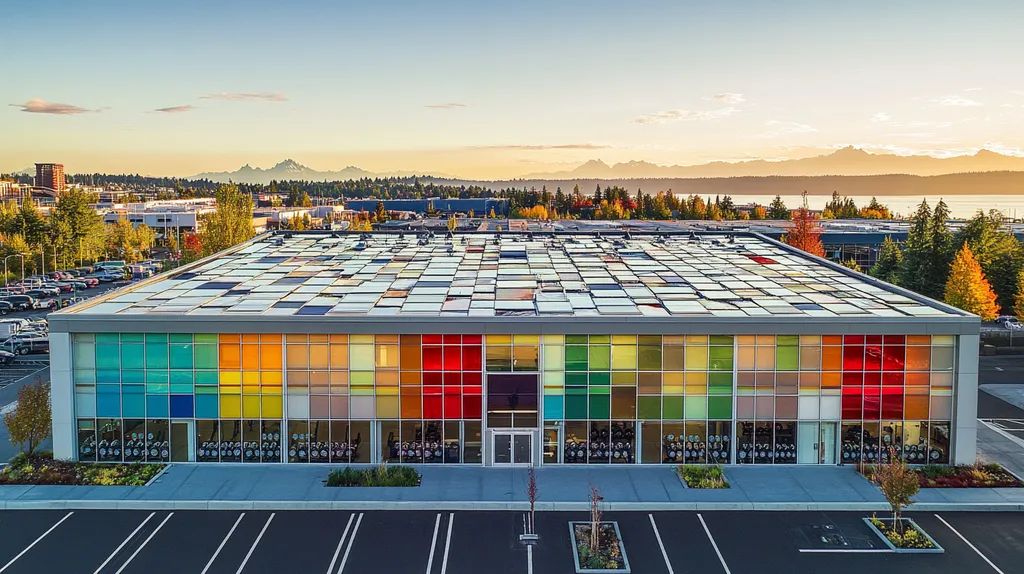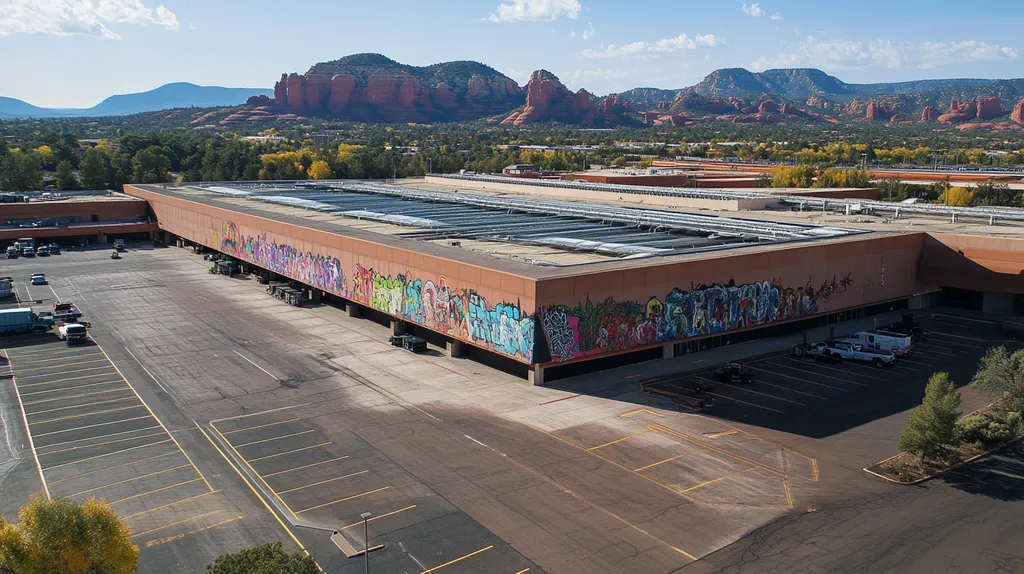Commercial roofing decisions impact up to 40% of a building’s maintenance costs, yet property professionals often lack clear guidance when evaluating material options. With premature roof failures costing businesses over $2.5 billion annually, choosing the right materials is crucial for protecting investments and operations.
From performance factors like durability and weather resistance to financial considerations including lifecycle costs, numerous variables influence optimal material selection. This comprehensive guide provides property professionals with an actionable framework for evaluating commercial roofing materials through six critical lenses.
Through detailed checklists and evidence-based insights, readers will learn to assess materials based on their unique facility needs while avoiding common selection pitfalls that lead to costly repairs and replacements.
SECTION 1: PERFORMANCE FACTORS
Selecting the right commercial roof material is essential for safeguarding investments and maintaining seamless operations. With roof-related issues accounting for nearly 25% of facility maintenance budgets, choosing high-quality materials is crucial to reduce risks associated with leaks, energy loss, and premature wear. This section highlights three critical performance factors: surface durability, water resistance, and insulation efficiency.
Roof Surface Durability
The durability of a roof surface significantly impacts its lifespan and the costs associated with maintenance. Commercial roofs must endure various environmental challenges, including severe weather and heavy foot traffic. For instance, TPO and PVC membranes are favored in sunny regions due to their UV resistance and flexibility.
Conversely, materials like asphalt shingles often have shorter lifespans in commercial applications. Property owners should weigh these factors carefully when choosing roofing materials. A durable roofing system decreases the frequency of repairs, leading to considerable savings over time.
Additionally, recent advancements in roofing technologies have introduced options that not only offer durability but are environmentally responsible. Roofs made with recycled content or featuring reflective properties can provide added long-term benefits, enhancing overall roof performance and lifespan.
Key Action Items
Water Resistance and Drainage
Water resistance is a vital characteristic of any commercial roofing system. Inadequate water management can lead to leaks, mold, and structural damage, often resulting from stagnant water pooling on the roof. Incorporating designs like sloped systems or tapered insulation enhances drainage efficiency.
Membrane roofs, such as EPDM and TPO, provide excellent water resistance but must be installed correctly to minimize pooling risks. Innovations like self-healing membranes also enhance water resistance by sealing punctures, significantly extending the roof’s lifespan.
Regular inspections and maintenance are crucial to ensuring effective drainage. Property managers should conduct routine checks following heavy rainfall to promptly identify and address any drainage issues. This proactive strategy can lead to substantial savings on repair costs.
Key Action Items
Insulation and Ventilation Efficiency
Effective insulation and ventilation are essential for maintaining a comfortable indoor environment and maximizing energy efficiency. Well-insulated roofs can significantly lower heating and cooling costs, allowing property owners to make the most of their energy budgets. Roofs designed with high thermal resistance help maintain stable internal temperatures year-round.
Furthermore, proper ventilation prevents heat buildup in attics and other areas, which can damage roofing materials over time. Implementing energy-efficient roofing solutions, such as reflective coatings, further optimizes energy performance by minimizing heat absorption.
Facilities managers should assess insulation types according to their specific climate needs. For example, spray foam insulation works well in colder climates, while green roofs or roof gardens offer natural insulation advantages in urban environments.
Key Action Items
SECTION 2: FINANCIAL CONSIDERATIONS
When selecting roofing materials for commercial properties, it’s critical to understand their financial impact. The right choice can lead to significant savings or unexpected expenses down the line. Research shows commercial roofs can account for as much as 30% of a property’s maintenance budget throughout its lifespan. This section will examine initial installation costs, ongoing maintenance and repair expenses, and the potential for long-term savings, arming property professionals with the essential insights needed for informed decision-making.
Initial Installation Costs
The initial costs of installing commercial roofs can vary widely based on the choice of materials and design. For instance, traditional built-up roofs may offer lower upfront costs but frequently necessitate more maintenance. In contrast, more durable options, like metal roofs or high-performance thermoplastic polyolefin (TPO), typically come with a higher initial price but can provide greater longevity and resilience.
It’s vital to include labor costs in your budget, as these can vary depending on local market conditions and specific project complexities. Understanding these variables allows property owners to more accurately gauge the overall expense of their roofing projects. While attractive materials may offer perceived benefits, fully assessing total costs is essential.
Additionally, warranties associated with certain roofing options can affect initial pricing. Generally, longer warranties could indicate higher initial costs but can save on repairs during the warranty period. Evaluating these trade-offs is crucial for sound financial decision-making.
Key Action Items
Maintenance and Repair Expenses
Ongoing maintenance and repair expenses can have a substantial impact on the total cost of a roofing system. Studies indicate that property managers typically allocate between 1% to 3% of a building’s value annually for maintenance. Choosing the right materials can significantly lower these ongoing costs.
For instance, single-ply roofing systems like TPO are often easier to maintain compared to traditional built-up roofs. Their fewer seams and resistance to weather-related issues can lead to reduced repair frequencies, translating into significant savings over time. Conducting regular inspections can avoid escalation of minor issues that might result in high repair costs.
Investing in high-quality materials designed for local climate conditions can further minimize wear and tear, thereby reducing maintenance needs. While the initial investment in robust materials may seem higher, the long-term savings and fewer repairs often justify the expense.
Key Action Items
Long-Term Cost Savings
Long-term cost savings play a vital role in the decision-making process for commercial roofing materials. Energy-efficient roofs, such as those with reflective coatings, can significantly lower cooling costs. For example, buildings with white reflective roofs may save up to 20% on energy bills.
Moreover, materials that are tailored to withstand local environmental challenges typically offer greater savings in the long run. While investing in durable options like slate or metal roofs may require a higher initial investment, their longevity can lead to reduced replacement frequency and costs.
Additionally, various roofing materials may qualify for tax credits or rebates due to their alignment with energy efficiency standards. Exploring available government programs can help facility managers decrease their effective costs significantly. Lastly, a well-maintained roof contributes to enhanced property value, ultimately boosting potential resale value in the future.
Key Action Items
SECTION 3: COMPLIANCE REQUIREMENTS
Compliance with building codes and environmental regulations is not just optional; it’s essential for the longevity and safety of commercial roofing. When roofing practices fall short, the consequences can be severe; in 2020 alone, improper roofing was responsible for over 40% of commercial property damage. Property owners must navigate a complex web of requirements to prevent costly penalties and ensure safety. This section delves into critical compliance issues regarding building codes, inspections, and environmental standards that influence material selection and overall roofing strategies.
Building Codes and Standards
Building codes set the baseline standards for roof design and materials, varying by location. These regulations typically cover critical aspects such as load capacity, fire resistance, and weather durability. For example, buildings in hurricane-prone areas must utilize roofing materials designed to withstand extreme winds and heavy rain.
Neglecting these codes can lead to significant issues, including structural failures and hefty fines. Property owners may be shocked to discover that non-compliance can void insurance claims, putting them at financial risk. It’s essential to engage with local building departments to ensure roofing materials comply with current codes.
Additionally, some materials may be favored for their energy efficiency, promoting sustainability and potentially lowering costs. Compliant materials not only help avoid penalties but may also improve marketability and desirability of the property.
Key Action Items
Regulatory Inspections and Certifications
Regular inspections are crucial for maintaining compliance in roofing systems. Many jurisdictions mandate periodic assessments to guarantee that roofing installations meet defined standards. Non-compliance can lead to serious legal repercussions.
Obtaining certifications from manufacturers demonstrates that roofing materials meet or exceed performance standards. For example, choosing products certified by reputable organizations such as the American Society for Testing and Materials (ASTM) enhances credibility and compliance.
During inspections, elements such as installation quality and material integrity are evaluated. Hiring certified professionals for inspections can uncover potential issues early, saving time and money over the roof’s lifespan.
Key Action Items
Environmental Compliance
Modern commercial roofing projects must adhere to stringent environmental regulations. With a growing emphasis on sustainability, property owners are increasingly responsible for considering the environmental impact of roofing materials. Eco-friendly options can help achieve LEED (Leadership in Energy and Environmental Design) certifications and enhance asset value over time.
Property managers must also keep an eye on local regulations regarding stormwater management and pollutant runoff. By choosing appropriate roofing materials, businesses can minimize environmental risks and comply with government initiatives aimed at reducing urban pollution.
Additionally, proper disposal of old roofing materials is critical for environmental compliance. Many areas have specific regulations regarding waste disposal that can lead to legal issues if ignored. Partnering with contractors who understand these requirements facilitates responsible roofing practices.
Key Action Items
SECTION 4: RISK MANAGEMENT
Effective risk management is crucial for commercial roofing, as even small problems can lead to significant financial setbacks. Research indicates that leaks alone can cost property owners over $1,000 per incident in immediate fixes, not considering the potential damage to inventory and equipment. By adopting a proactive roofing strategy, property managers can forestall these costly events and reinforce the integrity of their buildings. This section covers three essential risk management topics: leak detection and prevention, weather damage mitigation, and structural integrity assessment.
Leak Detection and Prevention
Leaks rank among the most common issues impacting commercial roofs and can escalate rapidly if left unchecked. Cutting-edge leak detection technologies, such as moisture mapping and infrared thermography, empower property managers to spot problems early. Routine inspections, at least twice a year, are vital for minimizing leak risks.
Additionally, it’s essential to maintain the roof’s drainage system. Clogged drains can lead to water pooling, raising the likelihood of leaks. Implementing preventive measures like regular cleaning can greatly reduce these risks.
In certain cases, applying protective coatings can further stave off moisture intrusion. These coatings offer a waterproof barrier, extending the roof’s lifespan while lowering maintenance expenses. Training staff to recognize early leak indicators adds an extra layer of protection.
Key Action Items
Weather Damage Mitigation
Extreme weather can severely impact commercial roofs, causing immediate damage and long-term deterioration. High winds can lift shingles or membranes, exposing the structure beneath. Utilizing wind-rated materials and implementing proper installation techniques can significantly reduce weather-related risks.
Moreover, fortifying building systems against severe weather events lowers overall risk. Roofs engineered to withstand local climate conditions tend to be more resilient. Investing in high-performance materials often yields longer service life and fewer repairs.
Incorporating safety features, such as reinforced edges and impact-resistant coverings, provides added protection. Regular evaluations before and after storm seasons enable property managers to identify vulnerabilities and address any weaknesses swiftly.
Key Action Items
Structural Integrity Assessment
The structural integrity of a commercial roof is vital to the overall safety of the building. Property managers should conduct systematic assessments to ensure the roof can support its intended loads. Modifications in roof usage can impact structural stability, making these evaluations essential.
Signs of structural issues may include sagging, cracked beams, or damaged materials. Timely inspections can uncover these problems early, preventing costly repairs and safety hazards. Partnering with qualified roofing professionals ensures that any structural concerns are addressed swiftly.
Investing in structural reinforcements is advisable, especially for older buildings. Using materials that bolster load-bearing capabilities extends the roof’s lifespan. Keeping detailed records of assessments and repairs aids in planning for future roofing needs or renovations.
Key Action Items
SECTION 5: OPERATIONAL PROCEDURES
Effective operational procedures are essential to ensuring the longevity and performance of commercial roofs. With nearly 40% of commercial roof failures stemming from insufficient maintenance, implementing structured protocols is vital. Routine inspections, prompt repair responses, and organized documentation can significantly enhance a roof’s lifespan while reducing costly damage. This section highlights the critical operational procedures that property professionals should prioritize.
Regular Inspection Schedules
Establishing a routine inspection schedule is crucial for catching potential roof issues before they escalate. The frequency of these inspections should depend on roof type, local climate, and the specific use of the building. For example, flat roofs may benefit from quarterly inspections, while sloped roofs could be checked semi-annually.
A comprehensive inspection should assess the roof surface, flashings, gutters, and drainage systems. Early detection of small leaks or membrane degradation can safeguard against major water damage and expensive repairs. Utilizing advanced tools like drones or thermal imaging enhances the inspection’s effectiveness, making sure no area is neglected.
Keeping meticulous documentation during these inspections is key. Detailed records of findings, repairs, and maintenance history allow property managers to monitor the roof’s condition over time. This proactive practice equips managers with critical insights for making educated decisions regarding maintenance and repairs.
Key Action Items
Repair and Replacement Protocols
Having effective repair and replacement protocols is essential for reducing costs and maximizing a roof’s lifespan. Understanding when repairs are adequate and when a roof replacement is warranted is critical. Generally, localized issues like punctures or small leaks are best addressed with repairs.
However, extensive damage or heightened structural concerns may require a complete roof replacement. For example, roofs with multiple leaks, considerable wear, or significant environmental damage may necessitate a full overhaul. Accurate assessments help avoid prolonged downtime and ensure business continuity.
Timeliness is crucial for repairs. Delaying necessary fixes can escalate issues, leading to increased repair expenses. Having a swift response plan in place not only mitigates further damage but also minimizes potential financial losses.
Key Action Items
Documentation and Reporting
Thorough documentation and reporting are foundational elements of a successful roofing strategy. Accurate records of inspections, repairs, and maintenance activities empower property professionals to make informed decisions. This comprehensive history of the roofing system aids in budget forecasting and proactive management.
Regular reporting to stakeholders, including property owners and facility managers, promotes transparency and effective communication. These reports should summarize inspection findings, repair activities, and actionable recommendations, enhancing collaboration among teams.
Leveraging digital platforms can significantly streamline documentation processes. Asset management software enables easy access to records, integrates maintenance schedules, and allows property managers to review past actions effortlessly, ensuring that necessary future actions are prioritized.
Key Action Items
SECTION 5: OPERATIONAL PROCEDURES
Robust operational procedures are essential for maintaining the integrity and performance of commercial roofs. With nearly 40% of commercial roof failures due to insufficient maintenance, clear protocols are vital. Establishing regular inspections, timely repair strategies, and systematic documentation can prolong a roof’s lifespan and prevent expensive damages. This section details key operational procedures that property professionals must prioritize.
Regular Inspection Schedules
Regular inspections are crucial for identifying potential roof issues before they escalate into costly repairs. Establishing a systematic inspection schedule based on roof type, local climate, and building usage is essential. For example, flat roofs may benefit from quarterly checks, whereas sloped roofs might need inspections semi-annually.
A comprehensive evaluation should cover the roof surface, flashings, gutters, and drainage systems. Detecting minor leaks or membrane deterioration early helps avoid significant water damage. Advanced tools like drones or thermal imaging can enhance inspections, ensuring that no area is missed.
Detailed documentation of findings during inspections is key. Maintaining accurate records helps track the roof’s condition over time, giving property managers critical information for making informed maintenance decisions. Hiring certified roofing professionals guarantees thorough inspections and recommended best practices tailored to specific roofs.
Key Action Items
Repair and Replacement Protocols
Effective repair and replacement protocols can significantly extend the life of a commercial roof while controlling costs. It is essential to know when repairs are sufficient and when to consider roof replacement. Typically, localized repairs are advisable for issues like small punctures or minor leaks.
However, extensive damage characterized by multiple leaks or significant structural concerns may necessitate a complete roof replacement. Accurate assessments can help minimize downtime and maintain business operations efficiently.
Timeliness in executing repairs is critical. Delaying necessary fixes can exacerbate issues and escalate costs. Having a quick response plan in place can prevent further damage and financial losses. Always use high-quality materials and hire reputable contractors for repairs and replacements.
Key Action Items
Documentation and Reporting
Thorough documentation and reporting are cornerstones of effective roofing management. Keeping accurate records of inspections, repairs, and maintenance efforts empowers property professionals to make informed decisions. This comprehensive history serves as a valuable resource for budget forecasting and proactive management.
Regularly reporting to stakeholders, like property owners and facility managers, enhances communication and promotes transparency. These reports should summarize inspection results, repair activities, and recommendations for future actions, ensuring accountability among team members.
Leveraging digital platforms can streamline documentation processes. Asset management software allows easy access to records, integrates maintenance schedules, and facilitates review of past actions efficiently, prioritizing necessary future work. Proactive documentation helps safeguard against potential failures and optimizes long-term investments.
Key Action Items
The Bottom Line
With commercial roofing costs reaching up to 40% of facility maintenance budgets, property professionals cannot afford to make uninformed material decisions.
The data shows that premature roof failures cost businesses over $2.5 billion annually, largely due to inadequate material selection and maintenance practices.
Success requires a systematic approach across all critical areas: performance factors like durability and drainage, financial considerations including lifecycle costs, compliance with evolving regulations, comprehensive risk management, structured operational procedures, and long-term planning.
By following the actionable frameworks and checklists provided, property managers can make evidence-based roofing decisions that protect their investments while avoiding the common pitfalls that lead to costly failures.
The stakes are clear – implementing these proven strategies isn’t optional, it’s essential for sustainable facility operations.
FREQUENTLY ASKED QUESTIONS
Q. What factors impact the performance of commercial roof materials?
A. Three critical performance factors are surface durability, water resistance, and insulation efficiency. A durable surface can withstand environmental challenges, while effective water resistance prevents leaks and structural damage. Furthermore, proper insulation contributes to better energy efficiency, ultimately impacting operating costs.
Q. How do financial considerations affect commercial roof material choices?
A. Understanding initial costs, ongoing maintenance, and the potential for long-term savings is vital. Selecting materials that may have higher initial costs but lower maintenance can lead to more significant savings over time. It’s essential to analyze the total cost of ownership to make wise decisions.
Q. What compliance requirements should I consider for a commercial roof?
A. Compliance with building codes, inspection standards, and environmental regulations is crucial. Ensuring roofing materials meet local building codes prevents potential financial penalties and structural risks. Regular inspections and adherence to environmental standards help safeguard the property and its value.
Q. How can I manage risks associated with commercial roofing?
A. Implementing proactive leak detection, mitigating weather damage, and assessing structural integrity are key to risk management. Utilizing advanced technologies for early leak detection and performing regular assessments can help prevent costly repairs and extend the life of your roof.
Q. Why are operational procedures vital for commercial roofing?
A. Operational procedures ensure effective maintenance and timely responses to issues. Regular inspections and structured repair protocols help avoid costly damage and enable property professionals to extend roof lifespan through consistent documentation and proactive management.
Q. What are the benefits of using energy-efficient roofing materials?
A. Energy-efficient materials can significantly reduce cooling costs and enhance comfort indoors. These materials help reflect sunlight, lowering energy consumption, and may qualify for tax incentives. Long-term savings and increased property value are additional benefits of investing in energy-efficient roofing options.
Q. How important is documentation for commercial roofing projects?
A. Thorough documentation is essential for effective roofing management. Keeping accurate records of inspections, repairs, and maintenance helps property professionals track the condition of the roof over time, aiding in budget forecasting and facilitating informed decision-making.

